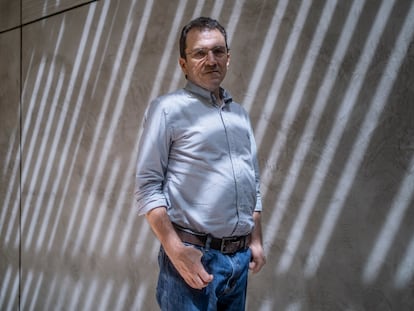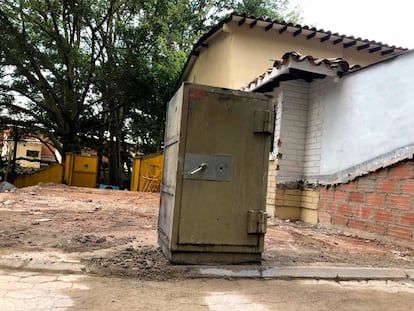Pablo Escobar, legend or disgrace?
Colombia ponders how the most universal drug trafficker and terrorist should be remembered 30 years after his death
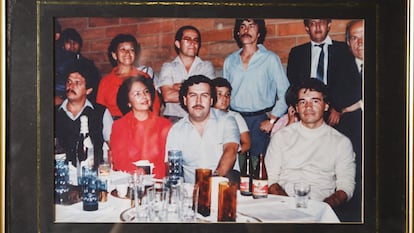

Two little lights illuminate the threshold of the room. On the table, a ceramic figure of the Santo Niño de Atocha, and above, hanging on the white wall, a portrait wrapped in a gold frame of Pablo Escobar, with his mustache and ringlet hairstyle. The altar in honor of the drug trafficker has been erected in this house for more than 20 years, where he is venerated as a pagan God. “Every day I ask the Lord to watch over his soul, to make him rest in peace,” says the owner, María Eugenia Castaño, who when she cleans around, as if in a reflex act, kneels before the image. “I’m no one to judge him, let the person up there do it,” she adds, crossing himself.
These small row houses, perched on a hill crisscrossed by cables, were built by Escobar in the 1980s, when he was the richest man in the world. Here he relocated poor families who lived in a landfill over which scavenger birds fluttered. The neighborhood bears his name and went unnoticed for a long time, but the universal fame that the Colombian bandit has achieved has made it a place of pilgrimage for foreign tourists visiting Medellín. The phenomenon produces curiosity and horror in equal parts. Thirty years after his death on December 2, 1992, Colombia wonders what to do with the uncomfortable memory of the drug trafficker, who has returned from the dead turned into a pop icon.
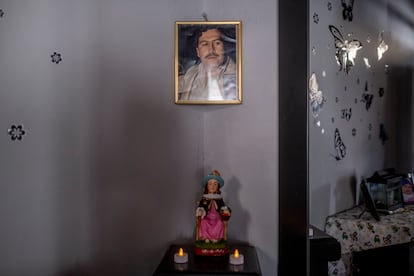
Escobar flooded the United States with cocaine between the 1970s and 1980s. On one of his estates, which he called Naples, he created a private zoo with rhinos, giraffes, hippos, zebras and kangaroos. At dusk he liked to watch the white birds he brought from Africa perch on the branches of the trees to sleep, as he had trained them. At that time he led, along with other partners, what is known as the Medellín cartel. He stood out from the rest of the drug traffickers for his extreme cruelty: he killed friends, enemies, judges, ministers, presidential candidates; He shot down a plane and planted a bomb in the most distinguished social club in Bogotá. His power and internalized sense of greatness was such that he believed he could be president of the Republic. He became a congressman and it was his own party that expelled him when it was discovered that he was actually a drug lord.
“He thought and acted like a politician. He had a deep conviction that, no matter how much money you have, if you don’t have political power, you don’t have real power. He understood that his empire was made of paper if it was not accepted by others,” says Marta Ruiz, journalist and member of the Truth Commission. She believes that we must stop being outraged by Escobar’s figure and “try to understand it.” Pablo is alive because he has a lot to say about Colombian society at that time: “He achieved what many of my generation wanted: to be rich.”
He is buried in a beautiful cemetery of low-level graves, the Montesacro Gardens. In his grave he rests with his parents and with the last hitman who accompanied him when he was killed, “El Limón.” The mother in the center, on the right the father and, on the left, Escobar. For the 30th anniversary, his brothers have decorated the place with an arch of white flowers and a rug on the sides. In the center, a black acrylic heart with red roses. A piece of marble from the Naples estate is embedded in the cement, recently painted black.
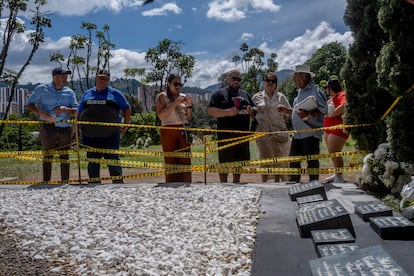
On a weekday, tourists approach the tomb, observe it for a few minutes and continue on their way. These are the narcotours offered by local guides.
Elvis, from Puerto Rico, wearing a Miami Heat t-shirt, takes photos with his cell phone.
— Why did you come here?
— He seems like a brutal character to me. I watched the Netflix series and what do I know, it made me curious,” says Elvis.
Nico comes from Canada with a group of ruddy friends.
“He was a piece of shit, killed a lot of people,” he states with contempt.
Federico works from 9 a.m. to 1 p.m. at the foot of the tomb recounting Escobar’s life in exchange for a tip. His friend Gilberto does it from 1 p.m. to 6 p.m. “All this has skyrocketed after the pandemic and because of the Netflix series. I’ve seen people kneel and everything. Thanks to this, so many people come to Medellín,” smiles Federico.
Alfonso Buitrago, author of the book El Chino. Pablo Escobar’s personal photographer, a delightful chronicle about the drug trafficker’s camera portraitist, believes that we should not shy away from the myth, not be scared by its ghost. In his opinion, the important thing lies elsewhere: “We need to explore much more the context in which Escobar became a particular chapter of the war on drugs. A common mistake is to think that Escobar is a Colombian product. International productions have wanted to show us that drug trafficking is a local peculiarity and that has marked the identity of Colombia. In reality, it is a very violent global phenomenon.”
In the Escobar neighborhood, it is obvious that Damian is a tourist. T-shirt, shorts and sandals with socks. He is doing a tour that a Polish agency promotes as “KOLUMBIA - ŚLADAMI ESCOBARA,” at a rate of $7,390 for 14 days touring Colombia. “You travel all over the country, but they name it Escobar to attract more customers,” explains Damian. Behind him, on the wall that marks the entrance to the neighborhood, there is a mural with Escobar’s face. It says: “Welcome, there is peace here.” In a nearby barbershop they sell caps, keychains, and refrigerator magnets. His memory has become an industry.
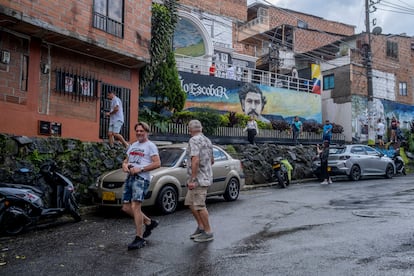
Omar Rincón, journalist, academic and essayist specialized in culture and entertainment, maintains that this is a phenomenon that is difficult to explain: “The guy was ugly, not cool at all and, according to all records, he is the worst thing that has happened to Colombia. But he was a popular hero, he meant the entrance to pure and simple capitalism for the poor class, who suddenly had money. He has become a pop star. Sadly, he is our Che Guevara.” For this to have happened, Rincón attaches a lot of importance to television: “Escobar was forgotten, but [Colombia series] El Patrón del Mal, which was supposed to be made to educate youth in the evil of Pablo, turned him into an adorable, lovable, endearing being. Then the Netflix version, Narcos, revives him as a handsome guy and spectacular in bed.”
When traveling abroad, Rincón sometimes finds himself presenting himself as someone from the land of Escobar. His thesis is that, with the arrival of the 21st century, a culture of success has been established that must be exhibited, as do reggaeton fans, influencers, and soccer players. “Everyone has evolved a narco style,” he continues. “Cristiano Ronaldo has narco attitudes, Trump too.” The unstoppable rise of Escobar’s ghost is framed in this context.
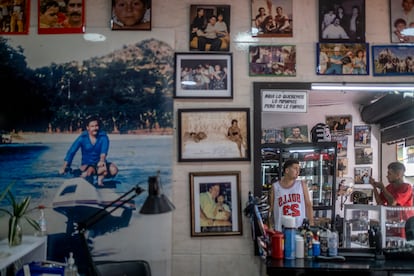
Pablo’s younger sister — there were seven siblings, he was the third — has been taking care of the tomb for 30 years, not letting it decay. If life gave her the opportunity to choose him again as a brother, she would do it. “Without hesitation,” says Luz María Escobar, 68, a woman with short dyed blonde hair. He may have been a womanizer, but he was an excellent father, she says. “He has left us a very great life lesson: we must say no to drug trafficking, no to weapons, no to violence and yes to life, reconciliation and love.” But how could he teach that if he did just the opposite? “Because he never forgave and that is why there were many victims.” She has had three children from whom at first she hid who their uncle was, but, when the time came, when the children began to hear stories at school, she had to tell them the harsh truth. There was something that tormented her: “I was afraid that one of them would turn out like Pablo.”
At this point, what to do with the sinister legacy of Pablo Escobar? Colombian society, traumatized by the terror he imposed in the 1980s, is now stunned to see his face printed on t-shirts. It is not easy to live with that contradiction. Escobar, the unscrupulous murderer, has risen from the grave to leave no one alone.
Sign up for our weekly newsletter to get more English-language news coverage from EL PAÍS USA Edition
Tu suscripción se está usando en otro dispositivo
¿Quieres añadir otro usuario a tu suscripción?
Si continúas leyendo en este dispositivo, no se podrá leer en el otro.
FlechaTu suscripción se está usando en otro dispositivo y solo puedes acceder a EL PAÍS desde un dispositivo a la vez.
Si quieres compartir tu cuenta, cambia tu suscripción a la modalidad Premium, así podrás añadir otro usuario. Cada uno accederá con su propia cuenta de email, lo que os permitirá personalizar vuestra experiencia en EL PAÍS.
¿Tienes una suscripción de empresa? Accede aquí para contratar más cuentas.
En el caso de no saber quién está usando tu cuenta, te recomendamos cambiar tu contraseña aquí.
Si decides continuar compartiendo tu cuenta, este mensaje se mostrará en tu dispositivo y en el de la otra persona que está usando tu cuenta de forma indefinida, afectando a tu experiencia de lectura. Puedes consultar aquí los términos y condiciones de la suscripción digital.
More information
Archived In
Últimas noticias
The complicated life of Francesca Albanese: A rising figure in Italy but barred from every bank by Trump’s sanctions
Reinhard Genzel, Nobel laureate in physics: ‘One-minute videos will never give you the truth’
Pinochet’s victims grapple with José Antonio Kast’s rise in Chile
How Japan is trying to avert ‘digital defeat’
Most viewed
- Pablo Escobar’s hippos: A serious environmental problem, 40 years on
- Reinhard Genzel, Nobel laureate in physics: ‘One-minute videos will never give you the truth’
- Why we lost the habit of sleeping in two segments and how that changed our sense of time
- Charles Dubouloz, mountaineering star, retires at 36 with a farewell tour inspired by Walter Bonatti
- The Florida Keys tourist paradise is besieged by immigration agents: ‘We’ve never seen anything like this’
